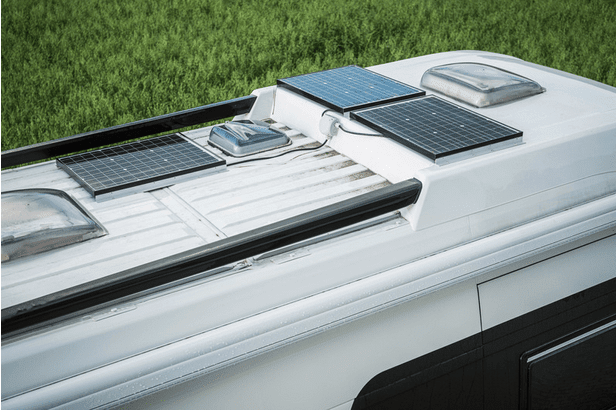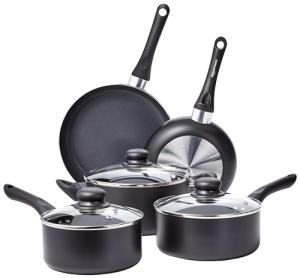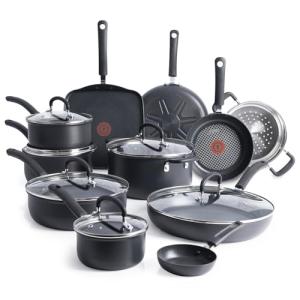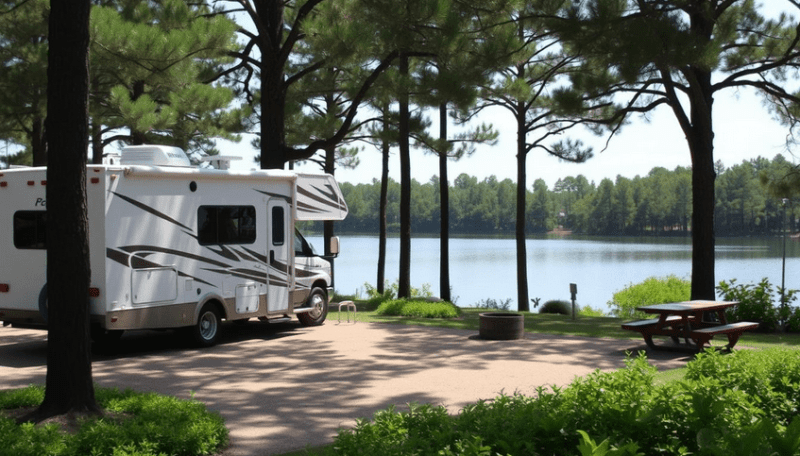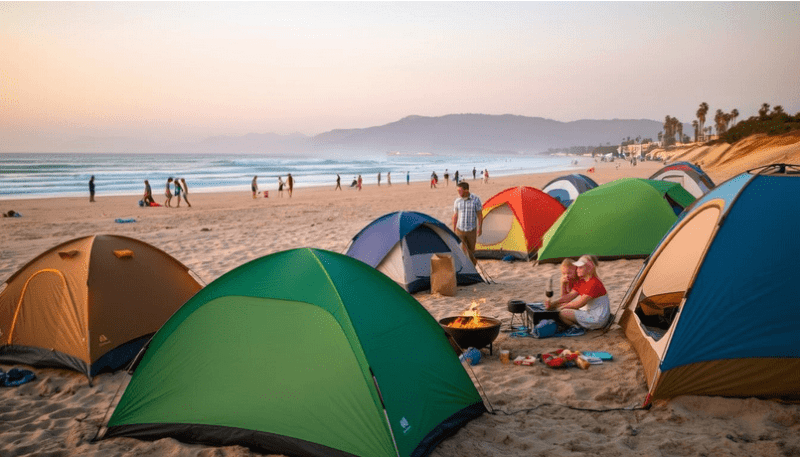Harnessing solar energy for RV camping empowers travelers to enjoy the freedom of the open road without the constraints of traditional power sources. Utilizing solar panels on an RV ensures a continuous, eco-friendly power supply, which is ideal for those looking to enhance their off-grid experience. Solar power eliminates the need for noisy generators and reduces dependency on electrical hookups at crowded campsites.

Exploring the basics of RV solar power and selecting appropriate panels are crucial steps for anyone considering this sustainable energy source. By understanding the differences in solar panel types and their power outputs, campers can make informed decisions to suit their needs. Equally important is the storage capacity, which ensures energy availability when the sun isn't shining.
Installation is another important consideration, determining both the efficiency and longevity of the system. With the right setup, RV enthusiasts can optimize solar panel performance, making camping trips more enjoyable. Equipping an RV with solar power offers the flexibility to explore remote areas without sacrificing modern comforts.
Key Takeaways
- Solar energy offers eco-friendly power for RVs.
- Proper solar panel selection maximizes efficiency.
- Installation affects long-term performance.
Understanding RV Solar Power Basics
Setting up a solar power system for an RV involves understanding the key components, differentiating between AC and DC power, and accurately calculating energy needs to ensure a smooth camping experience. This requires careful assessment of both equipment and power consumption.
The Components of an RV Solar System
An RV solar power system typically includes several essential components. Solar panels, usually mounted on the roof, are the starting point. They capture sunlight and convert it into electricity.
A charge controller is needed to regulate the energy flow from panels to batteries, preventing overcharging.
Batteries store energy for later use, allowing power availability when sunlight isn't sufficient. An inverter is crucial as well. It converts DC power from batteries into AC power, which most appliances use.
Cables and brackets ensure secure connections, while monitoring systems provide real-time data on power usage and battery status.
Difference Between AC and DC Power
Understanding the difference between AC and DC power is vital in RV solar setups. DC power comes from solar panels and batteries, often used for charging devices or running smaller appliances.
AC power is necessary for most household appliances, requiring an inverter to convert from DC. This distinction affects how electrical devices are chosen and connected in an RV.
Voltage and wattage considerations play a role too. For example, higher wattage appliances consume more power, impacting the energy budget. Proper planning ensures the right balance between DC devices and those needing AC via an inverter, enhancing efficiency.
Calculating Your RV's Energy Needs
To optimize an RV solar system, calculating the rig’s energy needs is essential. It begins by listing all electrical devices and their power consumption in watts.
Determine daily usage in hours to calculate amp-hours (Ah) or kilowatt-hours (kWh) required. For instance, if a fridge uses 50 watts and runs 10 hours a day, it consumes 500 watt-hours or 0.5 kWh daily.
Add up all devices' consumption to find total daily needs. Then, factor in peak sun hours to determine necessary solar panel wattage and battery capacity, securing enough stored energy.
Accurate calculations ensure sufficient power supply without oversizing or undersizing the components, providing efficient and reliable energy management for RV camping.
Selecting the Right Solar Panels

Choosing the appropriate solar panels for an RV camping setup involves understanding key differences in panel types, installation methods, and flexibility options. It's essential to consider how each type suits specific camping needs, space constraints, and budget.
Monocrystalline vs. Polycrystalline Panels
Monocrystalline solar panels are known for their efficiency and durability. They often have a sleek black appearance due to the use of single-crystal silicon. These types of panels are ideal for campers who require maximum energy output from limited space. Due to their efficiency, they are typically more expensive than other options.
Polycrystalline panels, on the other hand, tend to be less efficient but also more affordable. They are made from multiple silicon fragments melted together, giving them a blueish hue. While slightly larger for the same power output, they can be a cost-effective solution for those with more space on their RV roofs. Comparing cost, space, and energy needs is crucial when deciding between these two types.
Portable vs. Roof-Mounted Panels
Portable solar panels offer flexibility and can be positioned optimally depending on the sun’s location. They are advantageous for campers who frequently change locations or camp in shaded areas. This type allows easy setup and storage, and can be used even away from the RV.
Roof-mounted panels, meanwhile, provide a permanent and low-maintenance solution. They are installed directly onto the roof, maximizing space and keeping the RV mobile without extra setup time. While roof-mounted systems might be costlier to install initially, they offer convenience and constant energy capture during transit. Consider ease of use and mobility when choosing between these options.
Rigid vs. Flexible Solar Panels
Rigid solar panels are sturdy, with a durable frame, and are a common choice for most RV installations. They are highly efficient and reliable, offering long service life. These panels work well when the RV has a flat, steady surface readily available for installation.
Flexible solar panels, in contrast, offer a lightweight and adaptable solution. They can be bent slightly to fit curved surfaces, making them versatile for irregular RV roofs. While generally less efficient than rigid ones, they suit campers with space constraints or those who prefer simplicity in installation. Weighing efficiency, cost, and installation ease is necessary while selecting between rigid and flexible panels.
RV Solar Power Storage Options

Selecting the ideal solar power storage setup for an RV requires understanding different battery types and monitoring options. Lithium batteries offer efficiency and longevity, while battery monitors ensure optimal energy management.
Choosing the Right Battery Bank
The battery bank is a crucial component for storing solar energy in an RV. AGM batteries and lithium batteries are common choices. AGM batteries are maintenance-free and resistant to cold but can be heavier and have a shorter lifespan than lithium options.
Lithium batteries are lighter, have a longer lifespan, and can be discharged more deeply than AGM batteries. When choosing a battery bank, consider the power needs, weight constraints, and budget. A well-designed battery bank provides reliable energy storage and supports extended off-grid adventures.
Benefits of Lithium Batteries
Lithium batteries have gained popularity for RV solar setups due to their numerous advantages. They offer a longer lifespan, often up to 10 years, and can handle more charge cycles than traditional options. Lithium batteries are significantly lighter and more compact, making them easy to install and ideal for RVs with limited space.
They deliver consistent power output even at low states of charge. This efficiency makes lithium batteries a go-to choice for those looking to maximize their energy storage potential. While the initial cost may be higher, the long-term benefits and reduced maintenance can offset the expense.
Using Battery Monitors for Efficiency
Battery monitors are essential tools for managing energy use and ensuring efficient RV camping experiences. They track energy consumption and display data like remaining battery capacity and charge/discharge rates. This information helps in adjusting energy usage to extend battery life and prevents unexpected power shortages.
Installing a comprehensive battery monitoring system provides real-time feedback on energy storage and usage, allowing for proactive decisions on power management. It helps identify patterns in usage and potential issues. This proactive approach maintains battery health and aids in optimizing the overall performance of the RV's solar power system.
Installing Your RV Solar System

Setting up a solar power system for an RV involves several steps, including placing and securing solar panels, as well as connecting vital components like the charge controller and inverter. These tasks require proper tools and materials to ensure a reliable energy source while on the road.
Step-by-Step Solar Panel Installation
Begin by selecting the appropriate solar panels for the RV based on your energy needs and space available on the roof. Once chosen, gather tools such as a drill, screws, VHB tape, and safety gear.
Position the panels on the roof, ensuring they're free from shade. Use mounting brackets to secure panels in the right orientation. Wiring is crucial; run cables carefully to avoid damage. Install cable entry plates with butyl tape to ensure a waterproof seal.
Mark and drill holes for cables, maintaining a tight seal to prevent leaks. Double-check connections to align with the solar power system specifications. Testing the panels after installation ensures they function correctly, providing renewable energy supply during travels.
Mounting and Securing Solar Panels
Proper mounting of solar panels is critical for ensuring durability and efficiency. Start with selecting the right mounting brackets that suit the panel size and roof type. These brackets provide the necessary support against wind and movement.
Secure the mounting brackets using a combination of screws and VHB tape for added stability. A firm attachment is crucial for long-term reliability. Ensure panels have unobstructed access to sunlight for optimal performance.
Evaluate panel positioning regularly, especially if repositioning is required due to changes in travel patterns. Proper sealing around bracket installations prevents water damage, preserving the integrity of the RV roof.
Connecting the Charge Controller and Inverter
The charge controller regulates the power flow from solar panels to the battery, preventing overcharging. Install the charge controller close to the battery bank for improved efficiency. Connect the panels to the controller using appropriate gauge wires.
Next, link the charge controller to the battery, applying tight and clean connections. Install the inverter to convert the stored DC energy to AC power, making it usable for standard RV appliances. Inverters come in various sizes; ensure selection fits the power demand.
Test the system by checking voltage readings and running appliances to confirm proper setup. Regular maintenance and inspections help identify any issues, ensuring reliable power availability throughout camping adventures.
Optimizing Solar Performance While Camping

To effectively use solar power while RV camping, it's crucial to consider panel angling, maintenance, and energy consumption. These factors greatly enhance the efficiency and reliability of solar systems, ensuring your power needs are met with minimal fuss.
Maximizing Solar Intake with Proper Panel Angling
The angle of solar panels significantly impacts their efficiency. Positioning the panels perpendicular to the sun helps maximize solar intake. During the peak sunlight hours, generally between 10 a.m. and 4 p.m., adjust the panels frequently to keep them aligned with the sun’s path.
Solar tracking systems can assist with this process by automatically adjusting the panel angle.
While automatic systems are convenient, they can be costly. Manual adjustment is a viable option, requiring just a bit of time and effort. For those new to this, an inclinometer or compass can be helpful for determining the right angles. Keeping panels clean and free of obstructions, such as leaves or snow, is also important to maintain optimal performance.
Regular Maintenance of Solar Components
Regular maintenance of solar panels, batteries, and other components extends their lifespan and ensures consistent performance. Inspect panels for dirt, dust, and damage. Cleaning them with water and a soft cloth monthly prevents energy output reduction.
Battery maintenance is equally critical. Check electrolyte levels and top up with distilled water if necessary. Monitor battery charge levels using a voltmeter to ensure they're operating within safe limits.
Inverters and charge controllers should also be occasionally checked for signs of wear or damage. These components play a crucial role in converting and regulating energy. Ensure all connections are secure to avoid inefficient energy transfer or potential safety hazards.
Monitoring and Adjusting Energy Consumption
Monitoring energy consumption is essential for effective solar power management in RVs. Use a power meter to track amps and megabytes consumed, ensuring you're aware of how much energy appliances and devices use. This knowledge helps in making necessary adjustments.
Consider using energy-efficient appliances and LED lights to reduce consumption. Prioritize essential devices when energy levels are low.
Tracking energy use not only prevents power shortages but also takes advantage of stored kilowatt hours efficiently. By understanding energy usage patterns, it's possible to adjust behaviors and settings to make the most of the available solar power, especially during periods of limited sunlight.
Enhancing Your Off-Grid Camping Experience
When camping off-grid, solar power is a clean and efficient solution that significantly enhances freedom and flexibility. This approach not only supports an eco-friendly lifestyle but also allows campers to enjoy modern conveniences without compromising on the open, off-grid experience.
Advanced Boondocking with Solar Power
With solar technology, boondocking and dry camping become more accessible and enjoyable. Solar panels convert sunlight into electricity, providing a steady power source even in remote locations. For off-grid RV enthusiasts, installing a robust solar setup extends stays in secluded areas without relying on noisy generators.
RVers can maximize their energy output by strategically placing solar panels to capture direct sunlight. Keeping panels clean from dust and debris also optimizes efficiency. Having a portable solar unit allows flexibility to move panels to sunny areas as needed.
For an effective system, campers should invest in quality solar batteries to store surplus energy for use during cloudy days or at night. This ensures a consistent power supply for essential devices and appliances throughout their stay.
Eco-friendly Energy for a Sustainable Camping Experience
Solar power contributes to a more sustainable camping experience by reducing reliance on fossil fuels. It provides clean energy, minimizing the environmental impact of camping trips. The switch to solar allows campers to enjoy nature responsibly, preserving the environment for future adventurers.
Using eco-friendly gadgets and appliances further enhances sustainability. Energy-efficient LED lights, low-consumption fans, and solar-powered chargers conserve power. Campers can use energy wisely by monitoring usage and turning off devices when not in use.
Recycling and reducing waste during camping trips contributes to environmental conservation. Dedicated storage for recyclables and proper waste disposal ensure minimal footprint, complementing the eco-friendly ethos of solar camping.
Balancing Luxury and Efficiency in Your RV Appliances
For those who enjoy some luxury while off-grid, solar power supports modern RV appliances without sacrificing efficiency. High-tech refrigerators, microwaves, and air conditioning units can operate efficiently on a well-planned solar system.
Selecting appliances with Energy Star ratings ensures minimal energy consumption. Smart power management systems allow RVers to monitor and adjust their energy consumption to maintain efficiency. Balancing use among devices prevents overloading the system.
Stocking appliances suited to solar operation and using them judiciously means campers can maintain comfort and convenience without draining their solar resources. This approach provides a refined yet eco-conscious camping experience.
Choosing Solar Kits and Accessories
Selecting the right solar kits and accessories is crucial for efficient RV solar energy use. Buyers should focus on evaluating various solar panel kits and understanding what accessories are necessary for seamless installation and operation.
Evaluating Complete Solar Panel Kits
Selecting a solar panel kit starts with understanding the energy needs of the RV. Assess power consumption by listing the electrical devices typically used, such as lights, refrigerators, or charging stations. Consider the capacity of the solar array needed to meet these demands.
Review the specifications of RV solar panel kits available on the market, focusing on wattage, efficiency, and size. Foldable solar panels might offer flexibility for travelers who wish to save space. Additionally, ensure the kit includes high-quality solar panels and essential components like charge controllers and batteries.
It's important to check whether the kit is compatible with the specific RV setup. Some kits come with a solar prep feature, designed for easy integration with pre-wired RV systems. This can simplify the installation process significantly.
Necessary Accessories for Installation and Operation
A comprehensive solar kit should typically include cables, mounting brackets, and a cable entry plate. These components are vital for successful setup and operation. Mounting brackets ensure secure attachment of panels to the RV roof, which must withstand various weather conditions.
Cables and connectors should be suitable for carrying the solar power load efficiently, and a cable entry plate can help maintain a clean and secure installation by sealing entry points against the elements.
Having a compatible inverter is essential for converting solar energy into usable AC power. Battery monitors and solar charge controllers are important for maintaining battery health and ensuring safe energy storage.
Frequently Asked Questions
Solar power for RVs provides a sustainable energy solution with varying setups and requirements. Understanding the basics helps in making an informed decision about system capabilities and costs.
Can you run an RV completely on solar power?
Running an RV entirely on solar is feasible, depending on energy consumption needs. A well-designed system can handle basic appliances and lighting, but larger demands may require supplemental power sources like a generator or shore power.
How much solar power is needed to run an RV?
The solar power required depends on the number and type of devices used. Calculating average daily electricity usage and converting it to watts can determine the size of the solar array and battery capacity needed.
Can RV solar panels run air conditioning systems?
RV solar panels can power air conditioning units, but this typically requires a substantial investment in panels and batteries. AC units consume a large amount of power, often necessitating additional systems or backup sources to meet energy demands.
What appliances can a 100-watt solar panel power in an RV?
A 100-watt solar panel can power small devices like lights, fans, mobile chargers, and some electronics. It is generally insufficient for larger appliances and should be part of a larger system for more significant power needs.
What are the key components of a complete RV solar system with batteries?
Key components include solar panels, a charge controller, batteries, an inverter, and wiring. These elements work together to capture, store, and convert solar energy into usable electricity for the RV's appliances and systems.
How do you calculate the cost of setting up solar power for RV camping?
Cost calculation involves determining the number of panels, battery capacity, and additional equipment needed. Prices can vary widely depending on system size and brand preferences. Installation costs and any necessary upgrades to the RV's electrical system should also be considered.
DISCLAIMER
This document is provided for general information purposes only and should not be relied upon as providing legal advice, technical, or specific operational guidance to the reader, whether as to the practices described in the document or the applicable legal requirements and regulations. bestcampingdeals.com expressly disclaims any responsibility for liability arising from or related to the use or misuse of any information in this document.
